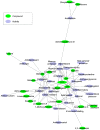Can Antiviral Activity of Licorice Help Fight COVID-19 Infection?
- PMID: 34201172
- PMCID: PMC8227143
- DOI: 10.3390/biom11060855
Can Antiviral Activity of Licorice Help Fight COVID-19 Infection?
Abstract
The phytotherapeutic properties of Glycyrrhiza glabra (licorice) extract are mainly attributed to glycyrrhizin (GR) and glycyrrhetinic acid (GA). Among their possible pharmacological actions, the ability to act against viruses belonging to different families, including SARS coronavirus, is particularly important. With the COVID-19 emergency and the urgent need for compounds to counteract the pandemic, the antiviral properties of GR and GA, as pure substances or as components of licorice extract, attracted attention in the last year and supported the launch of two clinical trials. In silico docking studies reported that GR and GA may directly interact with the key players in viral internalization and replication such as angiotensin-converting enzyme 2 (ACE2), spike protein, the host transmembrane serine protease 2, and 3-chymotrypsin-like cysteine protease. In vitro data indicated that GR can interfere with virus entry by directly interacting with ACE2 and spike, with a nonspecific effect on cell and viral membranes. Additional anti-inflammatory and antioxidant effects of GR cannot be excluded. These multiple activities of GR and licorice extract are critically re-assessed in this review, and their possible role against the spread of the SARS-CoV-2 and the features of COVID-19 disease is discussed.
Keywords: COVID-19; SARS-CoV-2; enoxolone; glycyrrhetinic acid; glycyrrhizic acid; glycyrrhizin; licorice; liquorice; virus.
Conflict of interest statement
This study is part of a more than 30-year collaboration between Perfetti Van Melle S.P.A. and the Istituto di Ricerche Farmacologiche Mario Negri IRCCS (IRFMN). It essentially concerns scientific support for the group’s activities with particular regard to product safety, the working environment, and updating of legislation. M.S., L.D., M.G., O.F., A.G. and M.B. are employees of IRFMN. The authors declare no conflict of interest. Perfetti Van Melle S.P.A. has no role in the collection, analyses, and interpretation of data, in the writing of the manuscript, or in the decision to publish the results.
Figures



Similar articles
-
Glycyrrhizic Acid Inhibits SARS-CoV-2 Infection by Blocking Spike Protein-Mediated Cell Attachment.Molecules. 2021 Oct 9;26(20):6090. doi: 10.3390/molecules26206090. Molecules. 2021. PMID: 34684671 Free PMC article.
-
Molecular screening of glycyrrhizin-based inhibitors against ACE2 host receptor of SARS-CoV-2.J Mol Model. 2021 Jun 24;27(7):206. doi: 10.1007/s00894-021-04816-y. J Mol Model. 2021. PMID: 34169390 Free PMC article.
-
Withanone from Withania somnifera Attenuates SARS-CoV-2 RBD and Host ACE2 Interactions to Rescue Spike Protein Induced Pathologies in Humanized Zebrafish Model.Drug Des Devel Ther. 2021 Mar 11;15:1111-1133. doi: 10.2147/DDDT.S292805. eCollection 2021. Drug Des Devel Ther. 2021. PMID: 33737804 Free PMC article.
-
Symptomatic Protective Action of Glycyrrhizin (Licorice) in COVID-19 Infection?Front Immunol. 2020 May 28;11:1239. doi: 10.3389/fimmu.2020.01239. eCollection 2020. Front Immunol. 2020. PMID: 32574273 Free PMC article. Review.
-
Potential therapeutic approaches for the early entry of SARS-CoV-2 by interrupting the interaction between the spike protein on SARS-CoV-2 and angiotensin-converting enzyme 2 (ACE2).Biochem Pharmacol. 2021 Oct;192:114724. doi: 10.1016/j.bcp.2021.114724. Epub 2021 Aug 8. Biochem Pharmacol. 2021. PMID: 34371003 Free PMC article. Review.
Cited by
-
The anti-SARS-CoV-2 effect and mechanism of Chiehyuan herbal oral protection solution.Heliyon. 2023 Jul 3;9(7):e17701. doi: 10.1016/j.heliyon.2023.e17701. eCollection 2023 Jul. Heliyon. 2023. PMID: 37483781 Free PMC article.
-
Discovering Traditional Chinese Medicine (TCM) Formulas for Complex Diseases Based on a Combination of Reverse Systematic Pharmacology and TCM Meridian Tropism Theory: Taking COVID-19 as an Example.ACS Omega. 2023 Jul 24;8(30):26871-26881. doi: 10.1021/acsomega.3c01489. eCollection 2023 Aug 1. ACS Omega. 2023. PMID: 37546617 Free PMC article.
-
Glycyrrhiza glabra L. Extracts and Other Therapeutics against SARS-CoV-2 in Central Eurasia: Available but Overlooked.Molecules. 2023 Aug 19;28(16):6142. doi: 10.3390/molecules28166142. Molecules. 2023. PMID: 37630394 Free PMC article.
-
Potential inhibitor for blocking binding between ACE2 and SARS-CoV-2 spike protein with mutations.Biomed Pharmacother. 2022 May;149:112802. doi: 10.1016/j.biopha.2022.112802. Epub 2022 Mar 9. Biomed Pharmacother. 2022. PMID: 35279013 Free PMC article.
-
Strategies for the Management of Spike Protein-Related Pathology.Microorganisms. 2023 May 17;11(5):1308. doi: 10.3390/microorganisms11051308. Microorganisms. 2023. PMID: 37317282 Free PMC article. Review.

